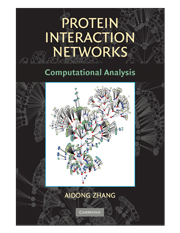Book contents
- Frontmatter
- Contents
- Preface
- 1 Introduction
- 2 Experimental Approaches to Generation of PPI Data
- 3 Computational Methods for the Prediction of PPIs
- 4 Basic Properties and Measurements of Protein Interaction Networks
- 5 Modularity Analysis of Protein Interaction Networks
- 6 Topological Analysis of Protein Interaction Networks
- 7 Distance-Based Modularity Analysis
- 8 Graph-Theoretic Approaches to Modularity Analysis
- 9 Flow-Based Analysis of Protein Interaction Networks
- 10 Statistics and Machine Learning Based Analysis of Protein Interaction Networks
- 11 Integration of GO into the Analysis of Protein Interaction Networks
- 12 Data Fusion in the Analysis of Protein Interaction Networks
- 13 Conclusion
- Bibliography
- Index
9 - Flow-Based Analysis of Protein Interaction Networks
Published online by Cambridge University Press: 28 January 2010
- Frontmatter
- Contents
- Preface
- 1 Introduction
- 2 Experimental Approaches to Generation of PPI Data
- 3 Computational Methods for the Prediction of PPIs
- 4 Basic Properties and Measurements of Protein Interaction Networks
- 5 Modularity Analysis of Protein Interaction Networks
- 6 Topological Analysis of Protein Interaction Networks
- 7 Distance-Based Modularity Analysis
- 8 Graph-Theoretic Approaches to Modularity Analysis
- 9 Flow-Based Analysis of Protein Interaction Networks
- 10 Statistics and Machine Learning Based Analysis of Protein Interaction Networks
- 11 Integration of GO into the Analysis of Protein Interaction Networks
- 12 Data Fusion in the Analysis of Protein Interaction Networks
- 13 Conclusion
- Bibliography
- Index
Summary
INTRODUCTION
The previous three chapters have discussed in detail the analysis of protein-proteinelusive interactions, which often compromise the effectiveness of the approaches presented so far. In this chapter, we will examine flow-based approaches, another avenue for the analysis of PPI networks. These methods permit information from other sources to be integrated with PPI data to enhance the effectiveness of algorithms for protein function prediction and functional module detection. Flow-based approaches offer a novel strategy for assessing the degree of biological and topological influence of each protein over other proteins in a PPI network. Through simulation of biological or functional flows within these complex networks, these methods seek to model and predict network behavior under the influence of various realistic external stimuli.
This chapter will discuss several flow-based methods for the prediction of protein function. The first section will address the concept of functional flow introduced by Nabieva et al. [221] and the FunctionalFlow algorithm based on this model. In this approach, each protein with a known functional annotation is treated as a source of functional flow, which is then propagated to unannotated nodes, using the edges in the interaction graph as a conduit. This process is based on simple local rules. A distance effect is formulated that considers the impact of each annotated protein on any other protein, with the effect diminishing as the distance between the proteins increases.
- Type
- Chapter
- Information
- Protein Interaction NetworksComputational Analysis, pp. 152 - 198Publisher: Cambridge University PressPrint publication year: 2009



